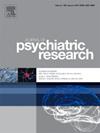Maladaptive beliefs, dissociation, and suicidal ideation in people with PTSD: Results from a national survey in Japan
IF 3.7
2区 医学
Q1 PSYCHIATRY
引用次数: 0
Abstract
Suicide is a major public health concern and people with post-traumatic stress disorder (PTSD) are at a higher risk of engaging in suicidal behaviors. Less is known about the factors that predict suicidal ideation in people with PTSD, especially in non-Western contexts. To test the hypothesis that post-traumatic maladaptive beliefs and dissociative symptoms would predict suicidal ideation, we analyzed data from the National Survey for Stress and Health in Japan. A total of 712 participants with probable PTSD who provided data at two time points, four months apart, were included for analysis. After controlling for age, gender, depressive symptoms, and baseline suicidal ideation, post-traumatic maladaptive beliefs (β = .090, p = .016) and dissociative symptoms (β = .080, p = .025), but not PTSD symptoms (β = .038, p = .323), predicted suicidal ideation at follow-up. The findings point to the potential importance of early interventions for maladaptive beliefs and dissociative symptoms in people with PTSD in order to reduce suicide risks.
创伤后应激障碍患者的不适应信念、分离和自杀意念:来自日本一项全国性调查的结果
自杀是一个主要的公共卫生问题,患有创伤后应激障碍(PTSD)的人有更高的自杀行为风险。人们对PTSD患者自杀意念的预测因素知之甚少,尤其是在非西方环境中。为了验证创伤后适应不良信念和分离症状会预测自杀意念的假设,我们分析了日本全国压力与健康调查的数据。总共有712名可能患有创伤后应激障碍的参与者,他们在两个时间点提供了数据,相隔四个月,被纳入分析。在控制了年龄、性别、抑郁症状和基线自杀意念后,创伤后适应不良信念(β = 0.090, p = 0.016)和分离症状(β = 0.080, p = 0.025),而非创伤后应激障碍症状(β = 0.038, p = 0.323)预测了随访时的自杀意念。研究结果指出,为了降低自杀风险,对PTSD患者的不适应信念和分离症状进行早期干预具有潜在的重要性。
本文章由计算机程序翻译,如有差异,请以英文原文为准。
求助全文
约1分钟内获得全文
求助全文
来源期刊

Journal of psychiatric research
医学-精神病学
CiteScore
7.30
自引率
2.10%
发文量
622
审稿时长
130 days
期刊介绍:
Founded in 1961 to report on the latest work in psychiatry and cognate disciplines, the Journal of Psychiatric Research is dedicated to innovative and timely studies of four important areas of research:
(1) clinical studies of all disciplines relating to psychiatric illness, as well as normal human behaviour, including biochemical, physiological, genetic, environmental, social, psychological and epidemiological factors;
(2) basic studies pertaining to psychiatry in such fields as neuropsychopharmacology, neuroendocrinology, electrophysiology, genetics, experimental psychology and epidemiology;
(3) the growing application of clinical laboratory techniques in psychiatry, including imagery and spectroscopy of the brain, molecular biology and computer sciences;
 求助内容:
求助内容: 应助结果提醒方式:
应助结果提醒方式:


